Fish bypass system
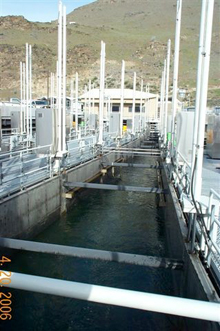
An innovative juvenile fish bypass system helps move young
salmon and steelhead quickly and safely past the Rocky Reach
Hydro Project.
The bypass includes two main
parts. The first is a collector system consisting of two
channels, 22 feet wide, 60 feet deep, and 120 feet long in the
forebay of the dam. The channel walls are made of fine,
non-abrasive, stainless steel screen. Along the outside of the
channels, 29 large submerged pumps work to create a strong
current that appeals to the natural instincts of juvenile
salmon and steelhead to attract them into the collector
channels in the dam’s forebay.
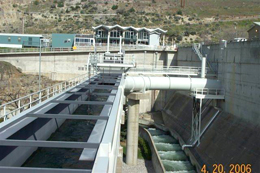 Once the
fish are in the collector, water moves them into the second
part of the system -- a steel tube , 9 feet in diameter
for most of its length. The tube passes through the dam and
extends a total of 4,600 feet around the back side of the
powerhouse, across the face of the spillway and then about
one-third mile down the east side of the Columbia River before
the fish are returned to the river. The entire trip takes
young fish about six to eight minutes.
Once the
fish are in the collector, water moves them into the second
part of the system -- a steel tube , 9 feet in diameter
for most of its length. The tube passes through the dam and
extends a total of 4,600 feet around the back side of the
powerhouse, across the face of the spillway and then about
one-third mile down the east side of the Columbia River before
the fish are returned to the river. The entire trip takes
young fish about six to eight minutes.
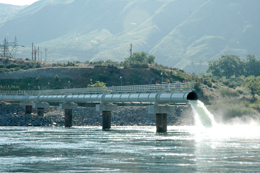 Construction of the bypass system
in 2002 was carefully planned so that all work in the river
would be done between fish migrations. Some of the large
components of the collector system, including the pump house,
were built at a peninsula upriver from the dam during the
summer of 2002, and then floated into place once salmon
migrations were finished.
Construction of the bypass system
in 2002 was carefully planned so that all work in the river
would be done between fish migrations. Some of the large
components of the collector system, including the pump house,
were built at a peninsula upriver from the dam during the
summer of 2002, and then floated into place once salmon
migrations were finished.
In addition to making the down-river trip easier for juvenile
salmon and steelhead, the bypass system will also reduce the
need to spill water over the dam. That water can then be used
to generate electricity more than offsetting the $107 million
cost of the bypass.
Bypass system background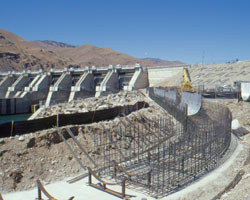
Starting in 1985, the PUD developed laboratory models
and tested prototype fish bypass systems for intercepting and
moving juvenile fish around Rocky Reach as they travel
downriver to the ocean. Screens were designed to steer young
salmon and steelhead away from the turbines and into a bypass
channel. None of the prototype screening systems tested
achieved the results experienced at other Columbia River hydro
projects. So a new approach was taken in 1995 -- a surface
bypass and collection system that appeals to the young
fish's natural instinct to migrate downriver near the
surface, following the water flow. This differs from
conventional turbine intake screens, which require fish to dive
into the turbine intakes before they are intercepted by the
screens. Also, after the prototype surface collector was added
in 1995, the fish guidance effectiveness improved for the
screen systems left in two units to enhance interim protection.
Because of the improvement in the screens' performance,
they have been incorporated into the final design of the fish
bypass system.
Sonar studies determined that fish generally travel in the
upper 60 feet of the river. The prototype was designed to use
natural and turbine-induced surface currents in the upper 60
feet of the flow to give fish an alternative to diving into the
turbine intakes -- entering the bypass system instead.
Attractive features of this concept include the minimal volume
of flow that's lost, minimizing power losses, as well as
the relatively low installation cost.
Flows through the bypass pipe were occasionally diverted to an
evaluation facility, where the juvenile fish were examined to
identify species and condition. A 24-hour videotaping system
counted the number of fish using the bypass system.
To measure the collector's effectiveness in moving fish, a
few of the young salmon and steelhead were implanted with
electronic tags and released upstream of the hydro project
during the spring and summer testing period. The movements of
other test fish outfitted with acoustic tags were monitored as
they moved through the forebay to determine how they reacted to
the surface collector. These studies allowed biologists to view
3-dimensional movement of fish in the forebay as they
approached the fish bypass system and dam. This technique was
used for this reason first at Rocky Reach.
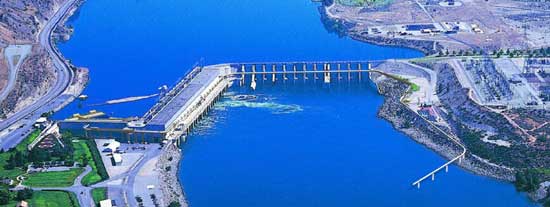 The prototype surface collection system
was modified each year, based upon test results from the
previous year. Increased flows into and through the collector,
plus improvements to the diversion screen/gatewell collection
system in certain units, provided very encouraging study
results in 1997. A second entrance was added to the surface
collector in 1998, but results in attracting fish were not as
good as anticipated. So in 1999, the second entrance to the
surface collector was modified to allow biologists to vary the
entrance width from a minimum of 22 feet to a maximum of 44
feet. This allowed biologists to analyze how water flows
affected, and which water flows were better at attracting fish.
The prototype surface collection system
was modified each year, based upon test results from the
previous year. Increased flows into and through the collector,
plus improvements to the diversion screen/gatewell collection
system in certain units, provided very encouraging study
results in 1997. A second entrance was added to the surface
collector in 1998, but results in attracting fish were not as
good as anticipated. So in 1999, the second entrance to the
surface collector was modified to allow biologists to vary the
entrance width from a minimum of 22 feet to a maximum of 44
feet. This allowed biologists to analyze how water flows
affected, and which water flows were better at attracting fish.
By 2000 and 2001, the District, in coordination with the
fisheries agencies and native American Tribes determined that
the configuration of the fish bypass system had been tested
satisfactorily and that installation of a permanent system was
warranted.
After final testing, the
permanent bypass system was installed in 7 months between fall
2002 and the beginning of the 2003 migration of juvenile salmon
in April towards the ocean. Each day from April 1 through
August 31 during bypass operations, the flow in the
bypass pipe is temporarily diverted for short periods to an
evaluation facility, where the juvenile fish are counted and
examined to identify species and condition.
The District has conducted nine
additional years of project passage and survival studies
following permanent construction, confirming its efficiency and
that survival of young fish using the bypass system is nearly
100 percent.